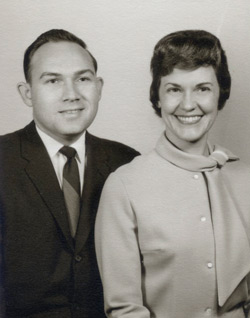
Today the phenomenon is fairly common; as evidenced by Bill and Hillary Clinton, Bob and Elizabeth Dole, Beyoncé and Jay Z, and Elton John and David Furnish. Today it’s not unusual for two supremely talented individuals to meet, fall in love, get married, and live happily ever after. We call the phenomenon “power couples.”
But 60 years ago, power couples were far less common. It’s not because talented people weren’t attracted to each other. Instead, it was because societal expectations and perceptions about dual-career households often eclipsed the notion that both were not only possible, but even likely given an ideal combination of ability, ambition, and opportunity.
Meet Bill and Helen Swank, residents at Friendship Village Columbus. While they’re certainly not Columbus’ original power couple, they no doubt occupy a unique place in the capital city’s history and in its emergence over the past half-century as a metro center that’s home to the state government, large public firms in the banking, insurance, and retail sectors; and ever-growing institutions of higher education. The Swanks flourished as Columbus came of age as a city.
When the Swanks arrived in Columbus as students at Ohio State in the late 1940’s, the city held the distinction of being the state capital of Ohio, but its population was less than half that of Cleveland. There were no professional sports teams (Woody Hayes had yet to arrive). There were no Fortune 500 firms, and no material attributes aside from its centralized location and an unlimited ability to grow in every direction. The Columbus skyline could be represented by a single raised finger, as the Lincoln-Leveque Tower was the only building that stood higher than 15 stories.
It was in this crucible of transformation that Bill and Helen fell in love, married, finished undergraduate and graduate school, raised a family and, individually, pursued careers that it would be difficult to imagine being replicated today. Bill served as executive vice president of Ohio’s Farm Bureau Federation for nearly 30 years before his retirement in 1996, while Helen taught in the vocal music department at The Ohio State University for 25 years. Bill was a counsel to every governor from William O’Neill to Ted Strickland. Helen helped guide the vocal music department’s rise from obscurity to prominence.
Both are modest when asked to describe how a dual-career couple could achieve such success. Even when pressed, both are unlikely to share too many details.
“When our kids used to ask me what I did all day at work, I told them I just talked to people,” said Bill, whose accomplishments include serving on the Ohio Board of Regents, as president of The Ohio State University Alumni Association, and on the boards of directors of Central State, Otterbein, and others. “I listened to what people said and helped them find common ground. It wasn’t anything more complicated than that.”
What Bill doesn’t say is that his ideas were probably decades before they become popular and widely adopted. After earning a doctorate in economics from Ohio State in 1962, his leadership and vision were counted upon to address the inherent conflict between rural and urban interests, and he was known for calling for an objective and analytical approach to promote understanding and resolution of critical policy issues. The C. William Swank chair in the university’s department of Agricultural, Environmental, and Development Economics is named in his honor.
Helen’s achievements are equally significant. The Helen Swank Research and Teaching Lab at Ohio State’s department of vocal music is named for Helen, whose pioneering work combining medicine, vocal technique, and speech and hearing therapy concepts helped make Ohio State a leader in voice healthcare and maintenance. The lab is world-renowned among vocal professionals.
Helen earned her master’s degree in voice from Ohio State in 1966 and she joined the faculty shortly thereafter. When university officials approached her to head up its emerging program, she was surprised they would ask someone with a master’s degree to lead a program full of doctorate-level candidates. “I was honored that they approached me,” said Helen, “but I told them that Bill had an important job, and that we still had children at home.” Nonetheless, Ohio State persisted. Imagine such a large and diverse organization doing something comparable today.
She served as head of the voice performance area for 13 of the 25 years she taught at Ohio State. Twice she received the university’s Alumni Distinguished Teaching Award and, in 1997, was the honored recipient of the School of Music’s Distinguished Service Award. Her former students grace the faculties of colleges and universities across the nation, and are also found in leading opera companies in America and Europe.
From their humble origins in Darke County, home of Greenville, in western Ohio, Bill and Helen Swank have truly carved out a remarkable career arc — correction: career arcs, plural.
“It’s been quite a journey,” Helen said. “We’ve had a great time.”
